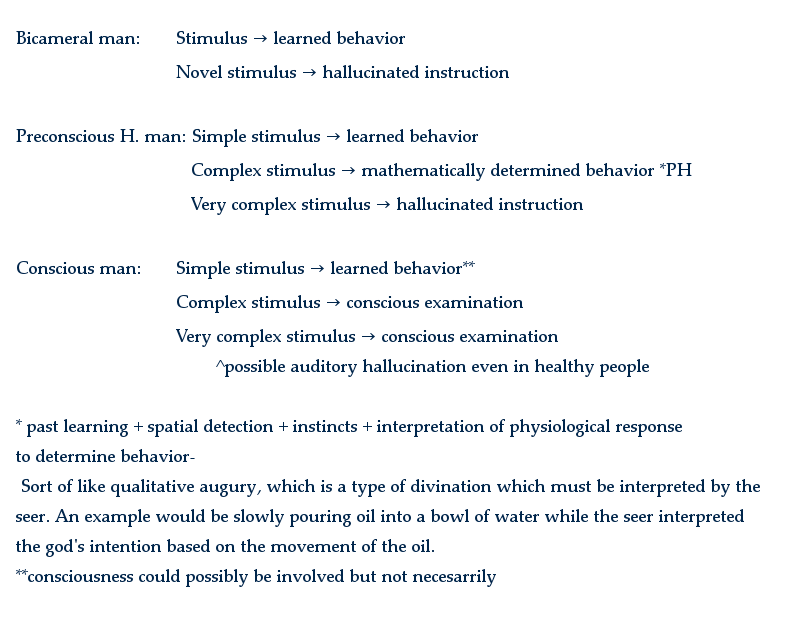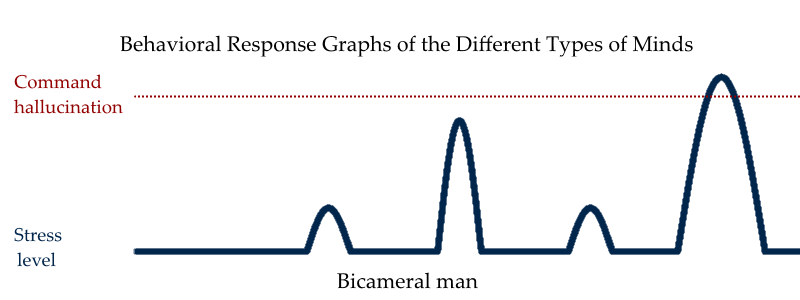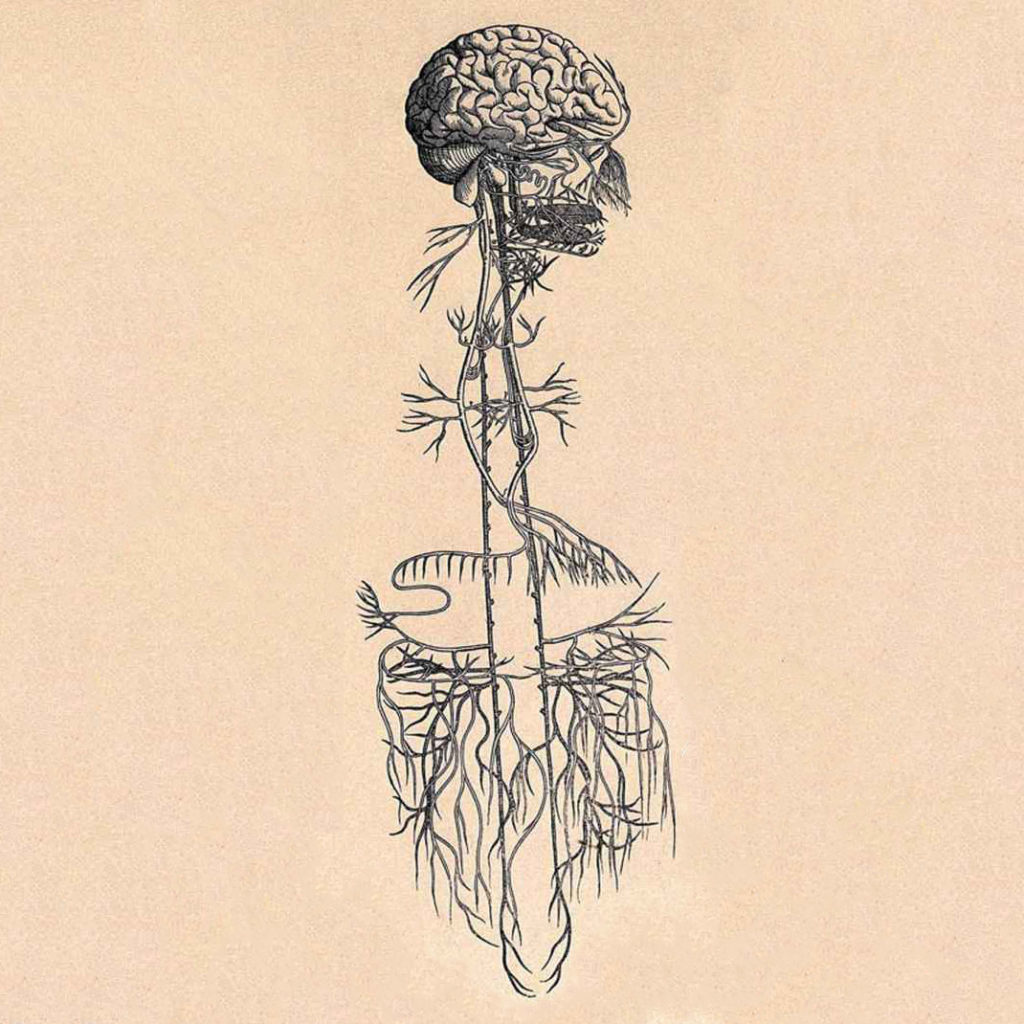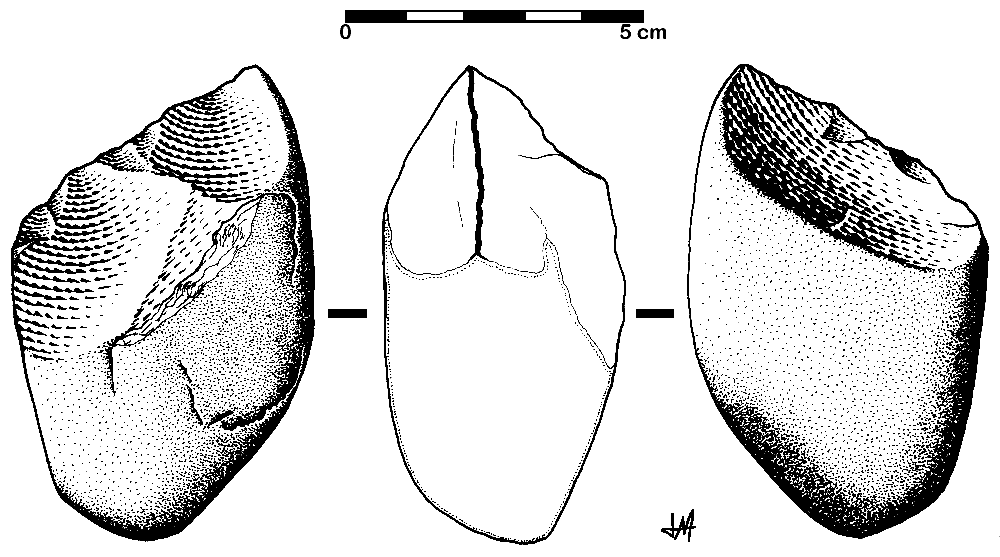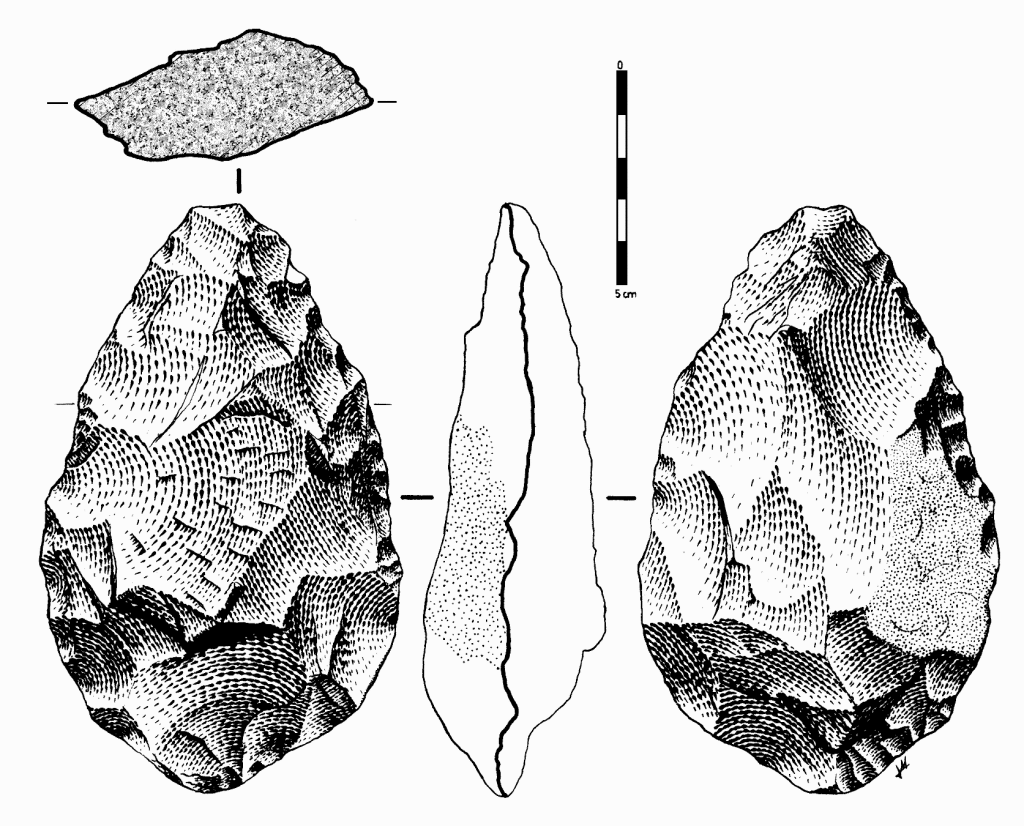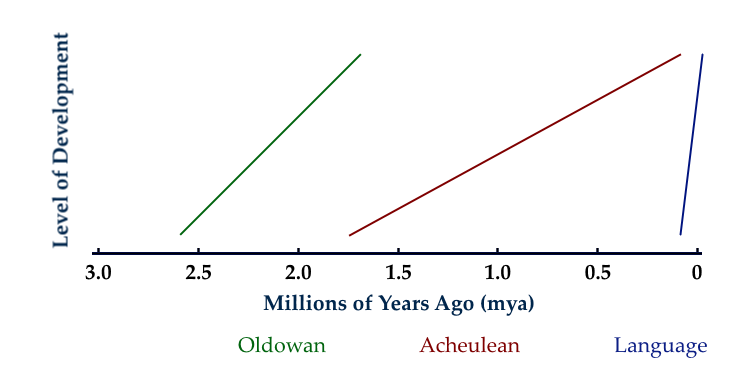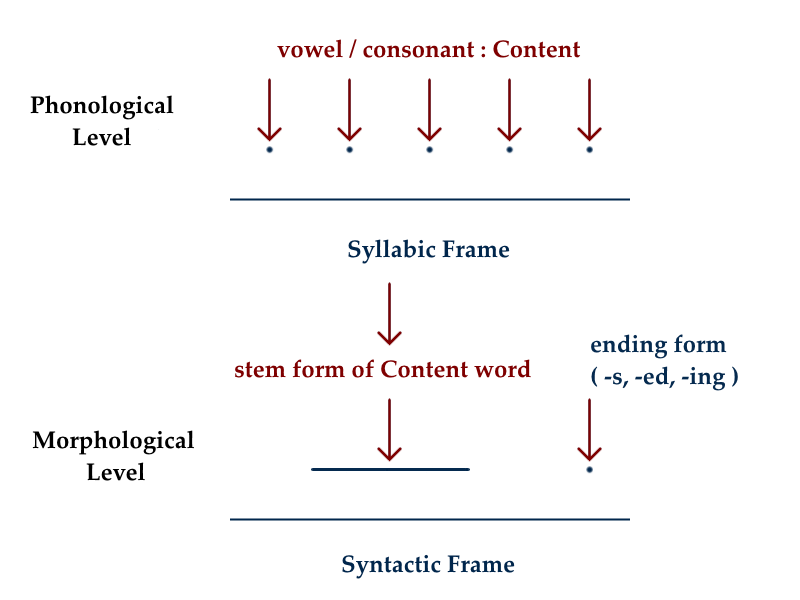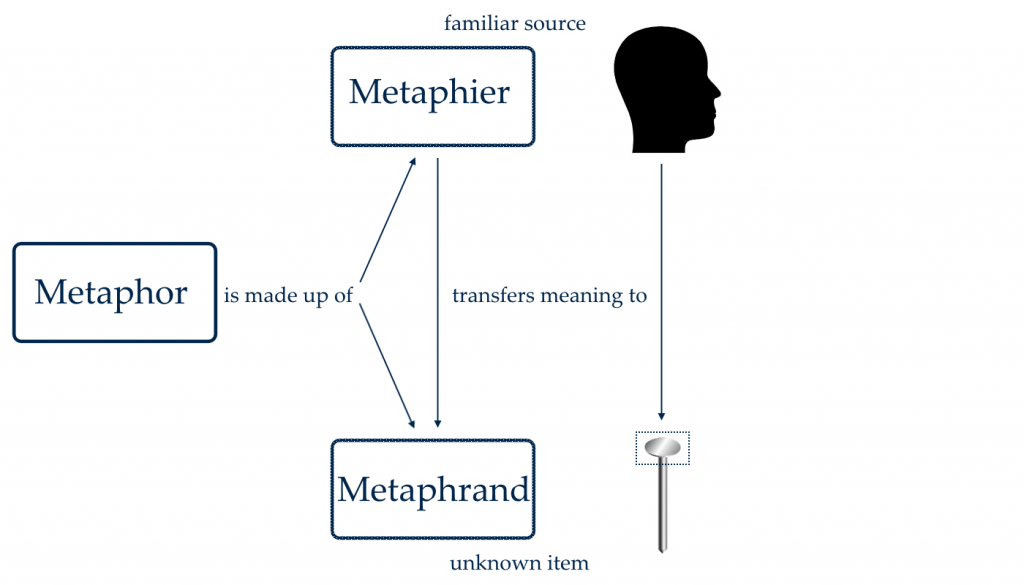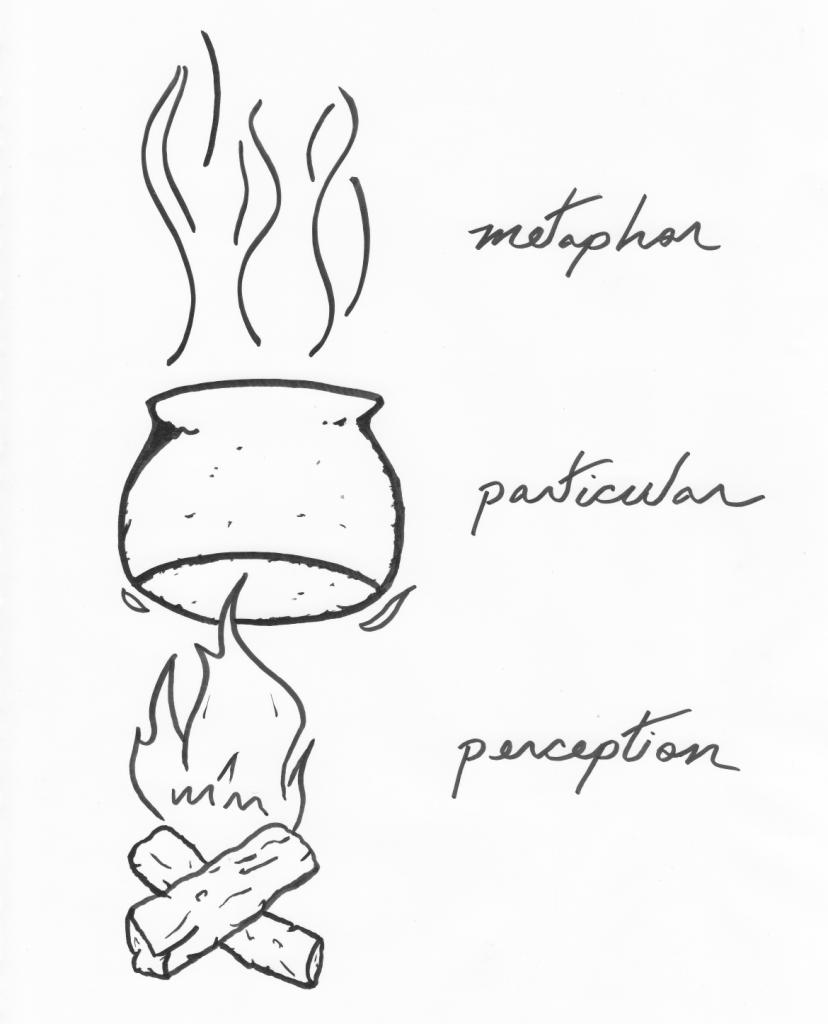According to Princeton psychologist Julian Jaynes in his seminal work The Origin of Consciousness in the Breakdown of the Bicameral Mind there was a time when man had no consciousness– which he defined as a “subjective conscious mind” or “an analog ‘I’ narratizing in a functional mind-space.” Jaynes goes on to say that the
Subjective conscious mind is an analog of what is called the real world. It is built up with a vocabulary or lexical field whose terms are all metaphors or analogs of behavior in the physical world. Its reality is of the same order as mathematics. It allows us to shortcut behavioral processes and arrive at more adequate decisions. Like mathematics, it is an operator rather than a thing or repository. And it is intimately bound up with volition and decision.(pg 55)[1]
Jaynes theorized that in ancient man the mind was divided into two chambers. [If you’re not familiar with the bicameral theory of mind please read the short summary here: https://manicmatter.com/origin-consciousness-bicameral-mind/.] One of these chambers was used for basic functions which the individual had either been taught by their culture (like hunting, making shelters, etc) or learned and repeated many times while the other chamber was only used in the rare circumstance that a person encountered a novel, dangerous situation. This type of person was said to be bicameral, they lacked the ability to introspect or reason with logic so when they encountered a situation like a bear suddenly emerging from a cave nearby the other chamber of their mind would use past experience to tell the man side of the mind what to do– this was experienced as an auditory hallucination.
In his investigation of consciousness Jaynes studied philosophy then animal behavior before moving on to human physiology, but he had become frustrated by a lack of progress before deciding to examine ancient literature and art. While comparing the Iliad to The Odyssey an interesting detail emerges, consciousness seems to be absent in the Iliad, the older work, where all action is seemingly driven by the gods. When compared with The Odyssey you’ll notice that Odysseus is capable of hallmarks of consciousness like long-term planning and deception. According to Jaynes, man acquired consciousness around 3,000 years ago in the Middle East (the date varies based on location), but in-between the time of the bicameral era and that of modern consciousness was a period in which the voices had begun to grow silent. More specifically, there was an intermediary period where much greater levels of stress were required to elicit an auditory hallucination. This time period is described in greater detail in the following paragraph by Jaynes:
It is quite likely, then, that as the bicameral organization of mind began to diminish, the decision-stress in novel situations would be much greater than previously, and both the degree and duration of that stress would have to become progressively more intense before the hallucination of a god would occur. And such increased stress would be accompanied by a variety of physiological concomitants, vascular changes resulting in burning sensations, abrupt changes in breathing, a pounding or fluttering heart, etc., responses which in the Iliad are called thumos, phrenes and kradie respectively. And this is what these words mean, not mind or anything like it. As the gods are heard progressively less and less, these internal response-stimuli of progressively greater stress are associated more and more with men’s subsequent actions, whatever they may be, even coming to take on the godlike function of seeming to initiate action themselves.(pg 258)[1]
Jaynes referred to these physiological responses as the preconscious hypostases which is Greek for “standing under,” between the time of the writing of the Iliad and The Odyssey they had begun to play an important role in man’s life. Some of these terms are “variously translated as mind, spirit, or soul” while others are “often translated as heart or sometimes as mind or spirit.”[1] Jaynes describes the most commonly mentioned ones in the Iliad as thumos, phrenes and kradie– terms which he translates as circulatory/muscular changes, respiratory changes, and cardiac changes. These three systems are intricately connected to the vagus nerve and it has been shown to exert control over each of them, as well as the gastrointestinal system which Jaynes translates as etor. Thumos, which Jaynes translates as circulatory/muscular changes, occurs about three times as often in the Iliad as any of the other terms which should be expected because of all of the battle and conflict taking place. But thumos isn’t just used to describe these internal sensations, it’s also used as an unvoiced metaphor as a container, and sometimes even as another person, as Jaynes describes in the following passage:
In several passages, menos or vigor is ‘put’ in someone’s thumos (i6: 5-8; 17: 451; 22: 312). The thumos is also implicitly compared to a person: it is not Ajax who is zealous to fight but his thumos (13: 73); nor is it Aeneas who rejoices but his thumos (13: 494; see also 14: 156). If not a god, it is the thumos that most often ‘urges’ a man into action. And as if it were another person, a man may speak to his thumos (u: 403), and may hear from it what he is to say (7: 68), or have it reply to him even as a god (9: 702).
All of these metaphors are extremely important. Saying that the internal sensations of the circulatory system is a thing into which strength can be put is to generate an imagined “space, here located always in the chest, which is the forerunner of the mind-space of contemporary consciousness. And to compare the function of that sensation to that of another person or even to the less-frequent gods is to begin those metaphor processes that will later become the analog ‘I.'”(pg 262 )[1]
Metaphor is sometimes thought of as a simple literary device, but its importance can’t be overstated. Metaphor is the often overlooked and undervalued engine which provides much of the power of language, and it allows for the exponential expansion of our otherwise concrete system of symbols. The word metaphor comes from the Greek word metaphora, meaning “a transfer,” particularly in “the sense of one word to a different word, literally “a carrying over.”[2] Like it’s name suggests, a metaphor transfers the usage of one term, or phrase, to describe something else because of a perceived similarity of the two things, or because of a certain relationship which the objects share.
According to the Bicameral Theory of Mind, metaphor was essential to the development of consciousness, which Jaynes defined as “that which is introspectable,” or “an analog ‘I’ narratizing in a functional mind-space.” What exactly is a functional mind-space, and what does metaphor have to do with it? Since a metaphor transfers the usage of one term, or phrase, to describe something else because of a perceived similarity of the two things, or because of a certain relationship which the objects share, it allows one to distill the essence of something so that it can be easily communicated to someone else– in a similar way metaphor could allow for the easier mental manipulation of what would otherwise be too complex to process, or store in short-term memory. In essence conscious man’s brain is distilling their environment and situation so that it can be communicated to the individual whereas preconscious hypostases man’s brain is performing a similar function except it’s reading the environment using feedback from various bodily systems and then relaying that information to the brain. [For an in-depth discussion of the importance of metaphor toward consciousness see my previous post: https://manicmatter.com/metaphor-mind/.]
Phrenes, or respiratory changes, are highly variable based on the activity that an individual is engaged in, these changes can cause a cascade of physiological responses throughout the entire body. Diaphragmatic breathing, for example, increases the efficiency of oxygen exchange which in turn slows the heartrate and it can lower or stabilize blood pressure. Jaynes points out how certain respiratory patterns are associated with environmental stimulations like the startle response being “correlated with partial or complete inhibition of breathing” and how activity or excitement increases “both the rate and depth of breathing with the resulting internal stimulation.” Jaynes goes on to explain how the respiratory cycle is also altered by speech, laughter, fright, etc, where generally speaking the more stimulated a person is the higher proportion of time they spend inhaling versus exhaling. So the respiratory system follows distinct, measurable patterns which reflect the outside world, or as Jaynes describes in the following quote:
The point I am trying to make here is that our phrenes or respiratory apparatus can almost be looked at as recording everything we do in quite distinct and distinguishable ways. It is at least possible that this internal mirror of behavior loomed much larger in the total stimulus world of the preconscious mind than it does in ourselves.(pg 264)[1]
Where the breath goes, the body follows.
In fact, it is the most common hypostasis still in use. When we in the twentieth century wish to be sincere, we still speak out of our hearts, not out of our consciousness. It is in our hearts that we have our most profound thoughts and cherish our closest beliefs.(pg 265)[1]
I think it is obvious to the medical reader that these matters we are discussing under the topic of the preconscious hypostases have a considerable bearing on any theory of psychosomatic disease. In the thumos, phrenes, kradie, and etor, we have covered the four major target systems of such illness. And that they compose the very groundwork of consciousness, a primitive partial type of consciousizing, has important consequences in medical theory.(pg 268)[1]
The third stage, unique to mammals, is characterized by a myelinated vagus that can rapidly regulate cardiac output to foster engagement and disengagement with the environment. The mammalian vagus is neuroanatomically linked to the cranial nerves that regulate social engagement via facial expression and vocalization.[5]
According to the polyvagal theory humans have physical reactions in various systems of the body associated with their facial expressions and the facial expressions of those around them– these changes can influence the cardiac, lungs, and gastrointestinal systems.
The polyvagal theory has wide ranging implications when it comes to many facets of human behavior and has been used extensively in therapy with people that suffer from PTSD or other traumas. Bessel van der Kolk who is a professor of psychiatry at the Boston University School of Medicine describes the importance of the theory in the following way:
The Polyvagal Theory provided us with a more sophisticated understanding of the biology of safety and danger, one based on the subtle interplay between the visceral experiences of our own bodies and the voices and faces of the people around us. It explains why a kind face or a soothing tone of voice can dramatically alter the way we feel. It clarifies why knowing that we are seen and heard by the important people in our lives can make us feel calm and safe, and why being ignored or dismissed can precipitate rage reactions or mental collapse. It helped us understand why attuning with another person can shift us out of disorganized and fearful states. In short, Porges’ theory makes us look beyond the effects of fight or flight and put social relationships front and centre in our understanding of trauma. It also suggested new approaches to healing that focus on strengthening the body’s system for regulating arousal.[6]
Dr. Puya Yazdi commented that the vagus nerve is “largely responsible for the mind-body connection” while Christopher Bergland, a Psychology Today writer, said that “When people say ‘trust your gut,’ they are in many ways saying, ‘trust your vagus nerve.’ Visceral feelings and gut instincts are literally emotional intuitions transferred up to your brain via the vagus nerve.”[7,8] The vagus nerve connects all of the major organs of the body, including all of the major preconscious hypostases, and allows them to work in concert while also integrating them with the brain, the muscles of the face, and an emergent “social engagement system” which is described in the following paragraph:
As the source nuclei of the primary vagal efferent pathways regulating the heart shifted from the dorsal motor nucleus of the vagus in reptiles to the nucleus ambiguus in mammals, a face–heart connection evolved with emergent properties of a social engagement system that would enable social interactions to regulate visceral state.[9]
[the] affected individual relies on environmental cues in order to accomplish goals or tasks. It is a disorder in personal autonomy that is influenced by individual psychological traits and can be helped through the intervention of other people. For example, adults diagnosed with attention deficit hyperactivity disorder have relied on special coaches to provide cues at appropriate times, helping them to make decisions about how to prioritize and order tasks.[10]
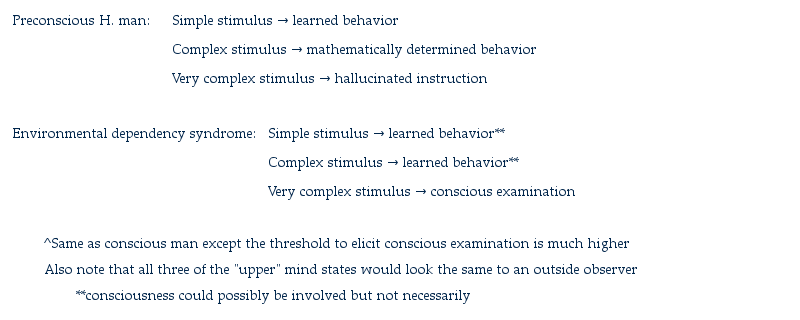

 Evidence shows that Neanderthals had a much larger occipital lobe (which is the visual processing center of the brain as it contains most of the visual cortex) and larger eyes than modern humans as well as “a significantly larger proportion of neural tissue associated with somatic (relating to the body) and visual function compared with the brains of AMH (anatomically modern humans).”[12] Another interesting feature of Neanderthal skulls/brains is the presence of an occipital bun, a prominent bulge at the base of the skull, which was common in early modern Europeans but is fairly rare nowadays.[13] As of now there are no substantiated theories as to the exact purpose of the occipital bun but one could surmise that it allowed for Neanderthal’s larger occipital lobe, this region of the brain is much more important for hunter-gatherers than agriculturalists. Whereas contemporary humans had evolved in Africa, Neanderthals evolved in the much higher latitudes of Europe where the landscape is colder and the light levels are much lower which is thought to be the reason why so much of their brain was dedicated to visual processing- this would lead to a reduction of brain space for social cognition.[14] Clive Gamble, an archaeologist at the University of Southampton states that “we have a social brain, whereas Neanderthals appear to have a visual brain.”[15]According to Jaynes language developed much later than most linguists theorize, primarily between the years 70,000 BC to 8,000 BC, and it can be traced most directly through inspecting the archaeological record for material goods. Jaynes states that rock tools which were primarily handaxes are among some of the only examples of technology which predates this range and that their construction was likely transmitted solely by imitation as “it is almost impossible to describe chipping flints into choppers in language.”[1] Anatomically modern humans had begun to migrate into Europe by around 43,000 BC, shortly afterwards Neanderthals had became extinct, sometime around 38,000 BC, it’s thought by some experts that their extinction was largely due to decreased cognitive flexibility which would lead to a decreased ability to learn and also adapt to climate change.[16] Looking at Jaynes’ timeline of language development (which wouldn’t necessarily be the same in all parts of the ancient world) by the time Neanderthals had became extinct only calls, modifiers, and commands were in use– a very rudimentary language which would be reactionary and not allow for abstractions like communicating something not present. In the development of language each new stage allowed for an increased ability to communicate and thus survive, Jaynes used the example of how the creation of a verb like ‘sharper’ allowed ancient man to communicate an entirely new concept which would increase the quality of tools which they created. Jaynes describes the importance of these changes in the following section:
Evidence shows that Neanderthals had a much larger occipital lobe (which is the visual processing center of the brain as it contains most of the visual cortex) and larger eyes than modern humans as well as “a significantly larger proportion of neural tissue associated with somatic (relating to the body) and visual function compared with the brains of AMH (anatomically modern humans).”[12] Another interesting feature of Neanderthal skulls/brains is the presence of an occipital bun, a prominent bulge at the base of the skull, which was common in early modern Europeans but is fairly rare nowadays.[13] As of now there are no substantiated theories as to the exact purpose of the occipital bun but one could surmise that it allowed for Neanderthal’s larger occipital lobe, this region of the brain is much more important for hunter-gatherers than agriculturalists. Whereas contemporary humans had evolved in Africa, Neanderthals evolved in the much higher latitudes of Europe where the landscape is colder and the light levels are much lower which is thought to be the reason why so much of their brain was dedicated to visual processing- this would lead to a reduction of brain space for social cognition.[14] Clive Gamble, an archaeologist at the University of Southampton states that “we have a social brain, whereas Neanderthals appear to have a visual brain.”[15]According to Jaynes language developed much later than most linguists theorize, primarily between the years 70,000 BC to 8,000 BC, and it can be traced most directly through inspecting the archaeological record for material goods. Jaynes states that rock tools which were primarily handaxes are among some of the only examples of technology which predates this range and that their construction was likely transmitted solely by imitation as “it is almost impossible to describe chipping flints into choppers in language.”[1] Anatomically modern humans had begun to migrate into Europe by around 43,000 BC, shortly afterwards Neanderthals had became extinct, sometime around 38,000 BC, it’s thought by some experts that their extinction was largely due to decreased cognitive flexibility which would lead to a decreased ability to learn and also adapt to climate change.[16] Looking at Jaynes’ timeline of language development (which wouldn’t necessarily be the same in all parts of the ancient world) by the time Neanderthals had became extinct only calls, modifiers, and commands were in use– a very rudimentary language which would be reactionary and not allow for abstractions like communicating something not present. In the development of language each new stage allowed for an increased ability to communicate and thus survive, Jaynes used the example of how the creation of a verb like ‘sharper’ allowed ancient man to communicate an entirely new concept which would increase the quality of tools which they created. Jaynes describes the importance of these changes in the following section:
The central assertion of this view, I repeat, is that each new stage of words literally created new perceptions and attentions, and such new perceptions and attentions resulted in important cultural changes which are reflected in the archaeological record.(pg 132)[9]
We share with other mammals a not very orderly repertoire of affects whose neural substrate was evolved long ago by natural selection into the limbic system deep in the brain. I wish here to mention three: fear, shame, and mating… By affect, psychology means to designate a biologically organized behavior that has a specific anatomical expression and a specific biochemistry, one that dissipates with time. But with consciousness, all this is changed.
I shall call this consciousness of a past or future affect an emotion, as that is how we describe it. And what I am proposing here is a two-tiered theory of emotions for modern human beings as distinguished from bicameral man and other animals. There are the basic affects of mammalian life and then our emotions, which are the consciousness of such affects located inside an identity in a lifetime, past or future, and which, be it noted, have no biologically evolved mechanisms of stopping.(pg 261)[1]
.
[Reading the section titled “Looking Forward Through the Iliad” on pg 257-272 of The Origin of Consciousness in the Breakdown of the Bicameral Mind will perhaps clarify some details of this essay. The full book can be downloaded as a PDF file here from a U.K. college professor’s site:
http://s-f-walker.org.uk/pubsebooks/pdfs/Julian_Jaynes_The_Origin_of_Consciousness.pdf.]
[1] Jaynes, J. (1976). The Origin of Consciousness in the Breakdown of the Bicameral Mind. Boston: Houghton Mifflin.
[2] Etymonline: Online Etmyology Dictionary
https://www.etymonline.com/word/Metaphor
[3]Lacey, B. C., & Lacey, J. I. (1974). Studies of heart rate and other bodily processes in sensorimotor behavior. In P. A. Obrist, A. H. Black, J. Brener, & L. V. DiCara (Eds.), Cardiovascular psychophysiology: Current issues in response mechanisms, biofeedback and methodology (p. 538–564). AldineTransaction.
[4] Porges, Stephen
https://books.google.com/books?id=s7nWIlnimY8C&pg=PA65&lpg=PA65&dq=%22pneumogastric+nerve%22+%22Darwin%22&source=bl&ots=85wyZGBEX8&sig=ACfU3U23WuDORXiMn8oW–4WhvOComu7Qw&hl=en&sa=X&ved=2ahUKEwje9t3W39zpAhVSCs0KHXecBq8Q6AEwAnoECAcQAQ#v=onepage&q=%22pneumogastric%20nerve%22%20%22Darwin%22&f=false
[5] Porges, Steven
https://www.sciencedirect.com/science/article/abs/pii/S0167876001001623?via%3Dihub
[6] Van der Kolk, B. A. (2014). The Body Keeps the Score: Brain, Mind, and Body in the Healing of Trauma. New York: Viking.
[7] Dr. Puya Yazdi
https://selfhacked.com/blog/32-ways-to-stimulate-your-vagus-nerve-and-all-you-need-to-know-about-it/
[8] Christopher Bergland
https://www.psychologytoday.com/us/blog/the-athletes-way/201302/the-neurobiology-grace-under-pressure
[9] https://www.ccjm.org/content/76/4_suppl_2/S86
[10] https://en.wikipedia.org/wiki/Environmental_dependency_syndrome
[11] https://en.wikipedia.org/wiki/Alexithymia
[12] https://www.ncbi.nlm.nih.gov/pmc/articles/PMC3619466/
[13] de Sousa AA, Sherwood CC, Mohlberg H, Amunts K, Schleicher A, MacLeod CE, Hof PR, Frahm H, Zilles K. (2010). Hominoid visual brain structure volumes and the position of the lunate sulcus. J. Hum. Evol. 58, 281–292 https://www.sciencedirect.com/science/article/abs/pii/S0047248410000023?via%3Dihub
[14] https://royalsociety.org/news/2013/neanderthal-social-skils-vision/
[15] https://www.livescience.com/27850-social-brain-beat-neanderthal-vision.html
[16] Kochiyama, T., Ogihara, N., Tanabe, H.C. et al. Reconstructing the Neanderthal brain using computational anatomy. Sci Rep 8, 6296 (2018). https://doi.org/10.1038/s41598-018-24331-0
